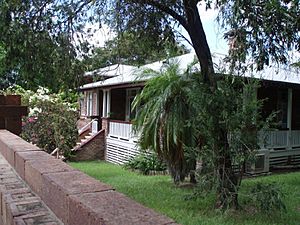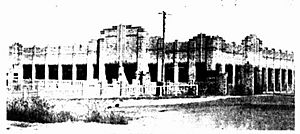History of Rockhampton Base Hospital facts for kids
Quick facts for kids Rockhampton Hospital |
|
|---|---|

Medical Superintendents Residence, 2009
|
|
| Location | Canning Street, The Range, Rockhampton, Rockhampton Region, Queensland, Australia |
| Design period | 1919 - 1930s (interwar period) |
| Built | 1936 |
| Official name: Rockhampton Hospital - Therapies Block and Medical Superintendents Residence, Outpatients and Sister Kenny Clinic and Medical Superintendent's Residence | |
| Type | state heritage (built) |
| Designated | 21 November 1997 |
| Reference no. | 601967 |
| Significant period | 1936 (fabric) 1930s (historical) |
| Significant components | residential accommodation - superintendent's house/quarters, fence/wall - perimeter |
| Lua error in Module:Location_map at line 420: attempt to index field 'wikibase' (a nil value). | |
Rockhampton Base Hospital is a historic hospital located on Canning Street in The Range, Rockhampton, Queensland, Australia. It was first opened in 1867. Some of its important old buildings, like the medical superintendent's house (built in 1936) and the Therapies Block (also known as the Outpatients Clinic and Sister Kenny Clinic, built in 1938), are protected as heritage sites. This means they are special and important parts of Queensland's history.
Contents
History of Rockhampton Hospital
The Rockhampton Hospital was built on its current site in 1867. This was the second hospital location in the city. The oldest buildings still standing today were built in the 1900s. Key historic parts include the former Outpatients Department, which had a special Sister Kenny Clinic from 1938. There was also a nurses' living area built in 1929 and a home for the hospital's head doctor from 1936. A strong brick fence along Canning Street is also part of the heritage site.
A hospital called the Port Curtis and Leichhardt District Hospital first opened in Rockhampton in 1858. In 1867, it was decided to move the hospital to a higher spot on the Athelstane Range. A large brick building was constructed there. More buildings were added in the 1870s and 1880s.
The Rockhampton Hospital grew slowly until a new law, the Hospitals Act (1923), brought many changes. This law meant the state government gave more money to hospitals. It made healthcare a responsibility of the state government. The Act also created hospital boards for different areas. These boards were in charge of raising money and managing the hospitals. Any money they couldn't raise was covered by the state and local governments.
The new hospital board for Rockhampton Hospital looked at the entire hospital site. One of their first projects was a maternity ward, built in 1928. This was due to the Maternity Act (1922). The maternity ward is no longer there. The next big building project was a nurses' living area, designed in 1926 and built in 1929.
Medical Superintendent's Residence
The same architects who designed the nurses' living area also designed the medical superintendent's home on Canning Street. Many homes for doctors were built at hospitals in the 1930s. This was when plans were made to house medical staff on site.
A brick fence was also built along the Canning Street side of the hospital. This fence matched the design of the new doctor's home. It was built to honor George Henry Sandrock, who had helped the hospital a lot in its early days. The fancy gates that were once part of the fence have been removed, but they are still kept on the hospital grounds.
Outpatients Department and Sister Kenny Clinic
The next major building at Rockhampton Hospital was a brick Outpatients' Department and Sister Kenny Clinic. It was also designed by the same architects. This building was officially opened on June 25, 1939.
At the opening, it was explained that the building was needed because the number of outpatients had grown a lot. The Hospital Board decided that the building would also have a Sister Kenny Clinic. This clinic was for treating people with poliomyelitis, a serious disease that can cause paralysis. Two nurses trained in Sister Kenny's special treatment method came from Brisbane to work at the clinic.
Sister Elizabeth Kenny became famous for her way of treating people with poliomyelitis. After a big outbreak of the disease in 1931–32, her unique methods were taken more seriously by doctors. This led to several clinics opening in Queensland, Australia, and even other countries. Before Sister Kenny, poliomyelitis was often treated by keeping the affected body parts still. But Sister Kenny believed in movement, using massage, warm baths, and constant nursing care.
Sister Kenny opened a private clinic in Townsville in 1932. The Queensland Government, through the Home Secretary, supported her work. They helped set up Kenny Clinics in Townsville, Rockhampton, Cairns, and Brisbane. The clinic at Rockhampton Hospital, opened in 1939, was the only one in Queensland built specifically for Sister Kenny's treatments.
The Outpatients' Department and Sister Kenny Clinic building is now used as a therapies block. It is a great example of the work of the architects, Hockings and Palmer. It was designed with different colored bricks and Art Deco style details.
After this building was constructed, the idea of a "modern hospital" became popular. These new hospitals focused on cleanliness and efficiency. They used new building methods and health technology. Many new buildings were added to the hospital site because of these ideas.
A five-story nurses' living area was built in 1950. In 1952, an isolation ward was added. In 1959, a four-story chest clinic was built to help fight diseases like tuberculosis. In 1970, a new multi-story surgical building began construction. Sadly, in 1986, the remaining old 1800s buildings and a nurses' living area from the 1930s were taken down.
Around 1997, the therapies block was also taken down, even though it was listed as a heritage site.
What the Buildings Look Like
The Rockhampton Hospital is on a large piece of land high up on the Athelstane Range. This is south of the Rockhampton town center. The hospital grounds are surrounded by Canning, North, Cambridge, and Quarry Streets. The important buildings we are focusing on are the therapies block and the medical superintendent's house, both on Canning Street. Also important is the fence along Canning Street.
Former Outpatients' Department and Sister Kenny Clinic
This is a large, one-story building made of brick and concrete. It is located near the northern corner of the hospital site, facing Canning Street. The building has an L-shape and a flat-looking roof hidden by a wall around the top. Along the Canning Street side and the entrance drive, there is an open walkway with brick pillars. These pillars extend above the roofline. The openings have brick panels with rectangular cutouts. The wall at the top steps up to form decorative Art Deco shapes over the main entrances. The building's walls have different colored brick bands and details around the windows.
1936 Medical Superintendent's Residence
This building was designed by the same architects as the Outpatients Department and Sister Kenny's Clinic. It uses similar materials and details. It is a one-story building made of dark brick and concrete, with a roof covered in corrugated iron. The house faces Canning Street. A large porch with a hipped roof dominates this side of the house. The porch is supported by brick pillars and wooden columns. The porch also has vertical wooden slats. Inside, the house has three bedrooms, a bathroom, a living room, kitchen, and dining room. The laundry area is under the house. The house is still very much like it was originally, though the kitchen and bathroom have been updated. Two tall evergreen trees are on either side of the Canning Street entrance.
Fence along Canning Street
Along the Canning Street side of the hospital, there is a strong brick fence. This fence helps connect the look of the brick buildings along this side of the hospital. The fence steps down along the street. At each step, there are brick pillars with decorative tops. Along the top of the fence, there is a line of rectangular cutouts. These are similar to the cutouts on the Outpatients Department building.
Why These Buildings Are Important
The Therapies Block and Medical Superintendents Residence of the Rockhampton Hospital were added to the Queensland Heritage Register on November 21, 1997. This means they are officially recognized as important historical places for several reasons:
- Showing Queensland's History: The Rockhampton Hospital shows how Rockhampton grew and became an important regional center. The former Sister Kenny Clinic is especially important for showing how medical care, particularly for poliomyelitis, developed over time.
- Unique Cultural Heritage: This building is special because it was the only clinic in Queensland built specifically for Sister Kenny's treatments. Other Kenny clinics were in buildings that were changed for that purpose.
- Learning About History: This building is still mostly in its original form. It could help us learn more about Sister Kenny's treatment methods.
- Good Examples of Architecture: The former Sister Kenny Clinic, the doctor's house from 1936, and the fence along Canning Street are great examples of the work of Rockhampton architects, Hockings and Palmer. They designed these buildings in a similar style to the Rockhampton Town Hall. The former Outpatients' Department and Sister Kenny Clinic is especially well-designed for its corner location.
- Beautiful Buildings: The hospital buildings are well-designed and look good together. They stand out in the street and are important parts of the area's look. The former nurses' living area, also designed by Hockings and Palmer, was a well-designed building that worked well for the tropical climate of Rockhampton, with lots of thought put into air flow.
- Important to the Community: The hospital site is important because of its connection to Sister Kenny. It has also been the main place for public healthcare in Rockhampton for about 130 years.
- Connected to Important People: The site is important because of its connection to the local architects, Hockings and Palmer.


